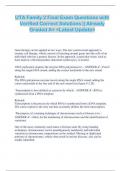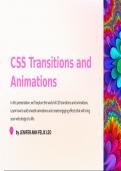UTA Family 2 Final Exam Questions with
Verified Correct Solutions || Already
Graded A+ <Latest Update>
Gene therapy can be applied in two ways. The less controversial approach is
somatic cell therapy, which consists of inserting normal genes into the cells of an
individual who has a genetic disease. In the approach, a particular tissue, such as
bone marrow cells that produce abnormal erythrocytes, is treated.
DNA replication requires the enzyme DNA polymerase to: - ANSWER ✔ ~Travel
along the single DNA strand, adding the correct nucleotide to the new strand.
Rational:
The DNA polymerase enzyme travels along the single DNA strand, adding the
correct nucleotide to the free end of the new strand (see figure 4-2, B).
Transcription is best defined as a process by which: - ANSWER ✔ ~RNA is
synthesized from a DNA template.
Rational:
Transcription is the process by which RNA is synthesized from a DNA template.
The correct option is the only one that accurately defines the term transcription.
The purpose of a staining technique of chromosomes such as Giemsa is to: -
ANSWER ✔ ~Allow for the numbering of chromosomes and the identification of
variations.
One of the most commonly used stains is Giemsa stain. By using banding
techniques, chromosomes can be unambiguously numbered, and individual
variation in chromosome composition can be studied. Missing or duplicated
portions of chromosomes, which often result in serious diseases, also can be
readily identified.
, An amniocentesis indicates a neural tube defect when an increase in which protein
is evident? - ANSWER ✔ ~Alpha fetoprotein
Other disorders can be detected with this procedure. These include most neural
tube defects, which cause an elevation of alpha fetoprotein in the amniotic fluid,
and hundreds of diseases caused by mutations of single genes.
An amniocentesis is recommended for pregnant women who: - ANSWER ✔
~Have a family history of genetic disorders
Amniocentesis is recommended only for pregnancies known to have an elevated
risk for a genetic disease or in women older than 30 to 35 years of age.
The most clinically useful technique for prenatal diagnosis of chromosomal
abnormalities at 3 months' (12 weeks') gestation is: - ANSWER ✔ ~Chorionic
villus sampling
Chorionic villus sampling consists of extracting a small amount of villous tissue
directly from the chorion. This procedure can be performed at 10 weeks' gestation
and does not require in vitro culturing of cells; sufficient numbers are directly
available in the extracted tissue. Thus the procedure allows prenatal diagnosis at
approximately 3 months' gestation rather than at nearly 5 months' gestation.
The term for an error in which homologous chromosomes fail to separate during
meiosis or mitosis is: - ANSWER ✔ ~Nondisjunction
Aneuploidy is usually the result of nondisjunction, an error in which homologous
chromosomes or sister chromatids fail to separate normally during meiosis or
mitosis.
Which clinical manifestations would be expected for a child who has complete
trisomy of the twenty-first chromosome? - ANSWER ✔ ~An IQ of 25 to 70, low
nasal bridge, protruding tongue, and flat, low-set ears
Individuals with this disease are mentally retarded, with IQs usually ranging from
25 to 70. The facial appearance is distinctive and exhibits a low nasal bridge,
epicanthal folds (which produce a superficially Asian appearance), protruding
tongue, and flat, low-set ears.
,What is the most common cause of Down syndrome? - ANSWER ✔ ~Maternal
nondisjunction
Nondisjunction during the formation of one of the parent's gametes or during early
embryonic development occurs in approximately 97% of infants born with Down
syndrome. In approximately 90% to 95% of infants, the nondisjunction occurs in
the formation of the mother's egg cell.
What syndrome, characterized by an absent homologous X chromosome with only
a single X chromosome, exhibits features that include a short stature, widely
spaced nipples, and webbed neck? - ANSWER ✔ ~Turner syndrome
In Turner syndrome, a sex chromosome is missing, and the person's total
chromosome count is 45. Characteristic signs include short stature, female
genitalia, webbed neck, shield-like chest with underdeveloped breasts and widely
spaced nipples, and imperfectly developed ovaries.
A person with 47, XXY karyotype has the genetic disorder resulting in which
syndrome? - ANSWER ✔ ~Klinefelter syndrome
A disorder in the chromosome (47, XXY karyotype) results in a disorder known as
Klinefelter syndrome.
What is the chromosomal variation that causes Klinefelter syndrome? - ANSWER
✔ ~Nondisjunction of X chromosome in the mother
Nondisjunction of the X chromosomes in the mother causes Klinefelter syndrome
in the majority of infants, and the frequency of the disorder rises with maternal
age.
What is the second most commonly recognized genetic cause of mental
retardation? - ANSWER ✔ ~Fragile X syndrome
Is the second most common genetic cause of mental retardation (after Down
syndrome).
What is the blood type of a person who is heterozygous, having A and B alleles as
codominant? - ANSWER ✔ ~AB
, When the heterozygote is distinguishable from both homozygotes, the locus is said
to exhibit codominance. An example is the ABO blood group, in which
heterozygotes having the A and B alleles express both of them as A and B antigens
on their red cells (forming blood group AB).
A couple has two children diagnosed with an autosomal dominant genetic disease.
What is the probability that the next child will have the same genetic disease? -
ANSWER ✔ ~One half
Affected heterozygous individuals transmit the trait to approximately one half of
their children; however, because gamete transmission is subject to chance
fluctuations, it is possible that all or none of the children of an affected parent may
have the trait. Nevertheless, when large numbers of matings of this type are
studied, the proportion of affected children closely approach one half.
When a child inherits a disease that is autosomal recessive, it is inherited from: -
ANSWER ✔ ~Both parents
In most cases of recessive disease, both parents of affected individuals are
heterozygous carriers.
People diagnosed with neurofibromatosis have varying degrees of the condition
because of the genetic principle of: - ANSWER ✔ ~Expressivity
Expressivity is the extent of variation in phenotype associated with a particular
genotype. If expressivity of a disease is variable, then the penetrance may be
complete but the severity of the disease can vary greatly. A well-known example
of variable expressivity in an autosomal dominant disease is type 1
neurofibromatosis.
Which genetic disease has been linked to a mutation of the tumor-suppressor
gene? - ANSWER ✔ ~Retinoblastoma
The gene responsible for retinoblastoma has been mapped to the long arm of
chromosome 13, and its DNA sequence has been extensively studied. This gene is
known as a tumor-suppressor gene; the normal function of its protein product is to
regulate the cell cycle so that cells do not grow uncontrollably.





